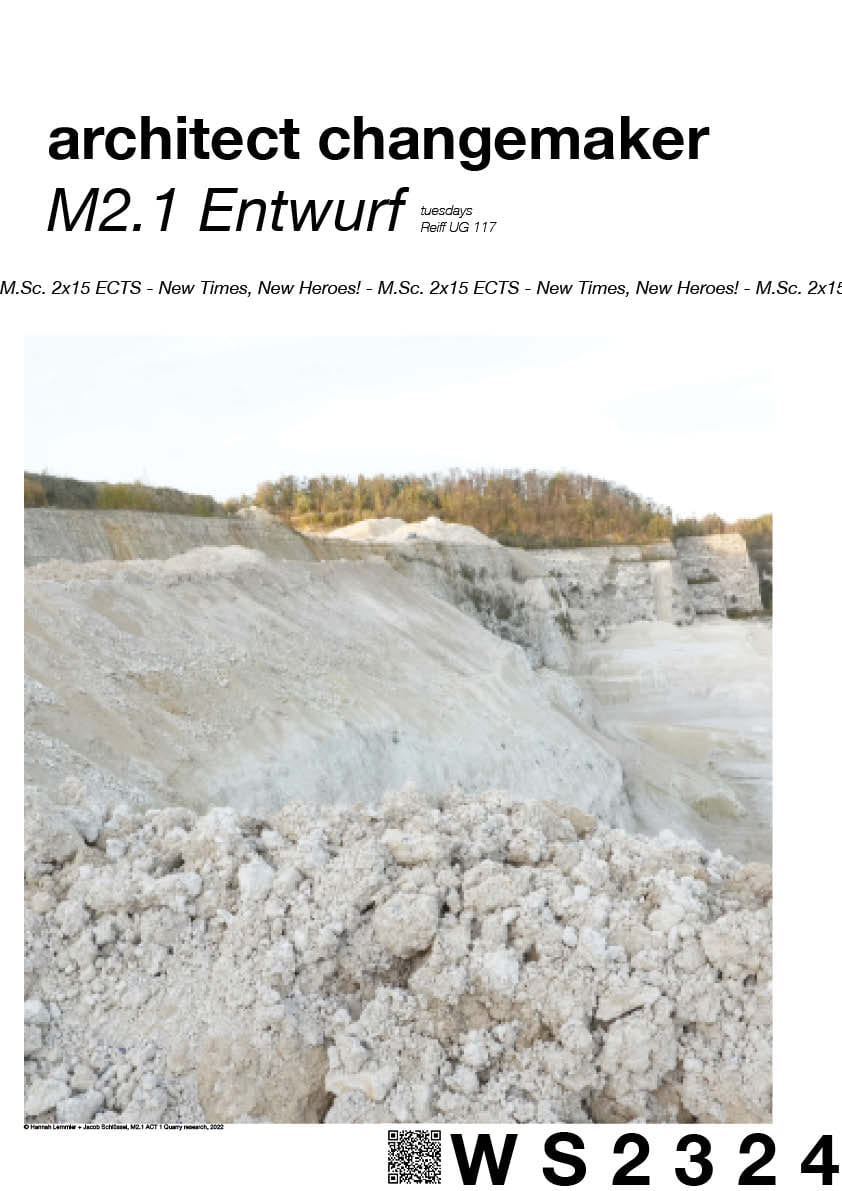
M2.1 MASTERSTUDIO the architect changemaker
New times, New Heroes!
The earth is a closed system, and our stay here is only temporary. The climate crisis is confronting current societies with radical transformations with tangible and non-tangible consequences in all aspects of life; from the social, the economic, the cultural, the natural to the building environment. Changes, big and small, radical and modest, are needed to rethink, prepare, envisage and manage the resulting complexity of society towards sustainable and convivial survival of mankind on a thriving planet. To do this, agents are needed to be the drivers of these changes. We wish therefore to rewrite the definition of the architect to match our current challenges and become more of a changemaker.
The studio “the architect-changemaker” looks towards the pre-industrialized concept of the masterbuilder. It reflects the idea of an integral approach to architecture, embedded in local context, local materials and local craftsmanship. We are in search for a new type of architect rather than a new type of architecture–the buildings expression will follow and represent the materials embodied characteristics!
In close collaboration with the hybrid practice of BC architects & studies & materials, the students will research within the Euregio Maas-Rhine potentially circular building material flows, develop samples of new geo-sourced materials, (ACT 1) design a folly with a chosen new material and finally develop an architectural project based on the raw material (ACT 2) – from its source to its processing to becoming space.
Following the M2.1 semester, where new materials from the Euregio‘s geo-resources are produced and applied, constructively tested and build in 1:20 earth models in a form of a folly design, we are scaling up in the second M2.2 semester in two directions: the self-developed material will be built in 1:1 prototypes as part of a wall structure. Here the students will independently manage the pre-planning of the construction site, the deployment and coordination of their workers, and the execution of the prototype. (ACT 3) At the same time, the place of origin of the original resource, the quarry or gravel pit located in the Euregio, which was investigated in M2.1, will be examined for its potential for subsequent use.
A future vision of the networking of local resources will be materialised in the form of a productive architecture, programatically closing loops of material waste streams to establish a circular building economy in the region around Aachen. The final design – (ACT 4)- of theM2.2is an individual project, ACT 1,2 and 3 are organized in teams.

M2.1 MASTERSTUDIO the architect changemaker
New times, New Heroes!
The earth is a closed system, and our stay here is only temporary. The climate crisis is confronting current societies with radical transformations with tangible and non-tangible consequences in all aspects of life; from the social, the economic, the cultural, the natural to the building environment. Changes, big and small, radical and modest, are needed to rethink, prepare, envisage and manage the resulting complexity of society towards sustainable and convivial survival of mankind on a thriving planet. To do this, agents are needed to be the drivers of these changes. We wish therefore to rewrite the definition of the architect to match our current challenges and become more of a changemaker.
The studio “the architect-changemaker” looks towards the pre-industrialized concept of the masterbuilder. It reflects the idea of an integral approach to architecture, embedded in local context, local materials and local craftsmanship. We are in search for a new type of architect rather than a new type of architecture–the buildings expression will follow and represent the materials embodied characteristics!
In close collaboration with the hybrid practice of BC architects & studies & materials, the students will research within the Euregio Maas-Rhine potentially circular building material flows, develop samples of new geo-sourced materials, (ACT 1) design a folly with a chosen new material and finally develop an architectural project based on the raw material (ACT 2) – from its source to its processing to becoming space.
Following the M2.1 semester, where new materials from the Euregio‘s geo-resources are produced and applied, constructively tested and build in 1:20 earth models in a form of a folly design, we are scaling up in the second M2.2 semester in two directions: the self-developed material will be built in 1:1 prototypes as part of a wall structure. Here the students will independently manage the pre-planning of the construction site, the deployment and coordination of their workers, and the execution of the prototype. (ACT 3) At the same time, the place of origin of the original resource, the quarry or gravel pit located in the Euregio, which was investigated in M2.1, will be examined for its potential for subsequent use.
A future vision of the networking of local resources will be materialised in the form of a productive architecture, programatically closing loops of material waste streams to establish a circular building economy in the region around Aachen. The final design – (ACT 4)- of theM2.2is an individual project, ACT 1,2 and 3 are organized in teams.